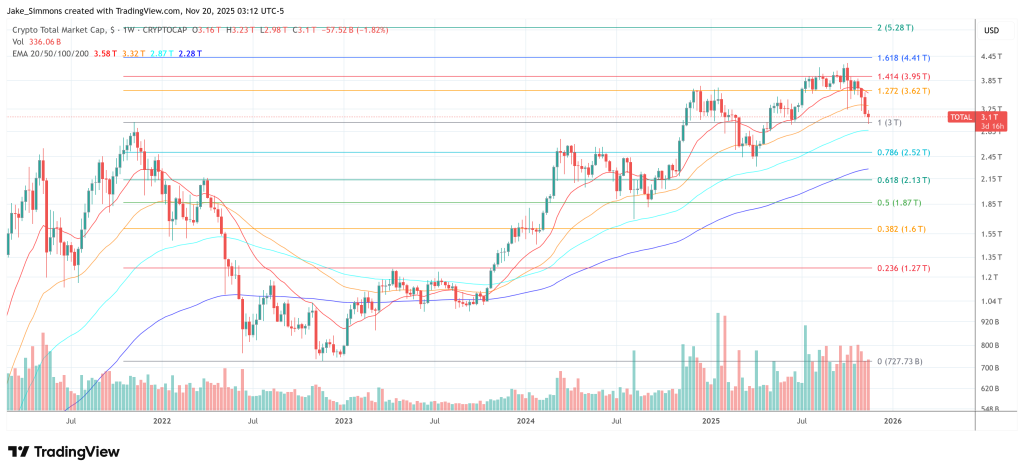Persistent, programmatic selling across major crypto assets has sparked fresh speculation that the market is still digesting cascading liquidations from October 10 — and that at least one large player is being unwound in the background.
On November 19, Multicoin Capital co-founder Tushar Jain wrote on X that “it feels like a big forced seller is in the market,” adding that “we are seeing systematic selling during specific hours.” He linked the pattern directly to the October 10 liquidation shock, calling it “probably a consequence of 10/10 liquidations” and concluding: “Hard to imagine this scale of forced selling continues for much longer.”
Jain has framed the current tape through the lens of his experience in 2022. On October 11, one day after the 10/10 flush, he warned that “it takes some time for all the bankruptcies to reveal themselves after a big liquidation flush like this.” According to him, in such episodes “big trading shops are running around trying to figure out what their exposure to insolvent counterparties is and that takes time.” When asked how long this process can last, he answered that “sometimes it takes weeks. Sometimes it takes months. It depends on what people do to try and patch the holes.”
That delayed discovery of losses is central to the emerging “forced seller” narrative. Rather than a single cathartic event, the 10/10 wipeout is being treated by professionals as the starting point of a longer adjustment, where risk is reduced gradually as lenders, counterparties and risk desks work through opaque exposures.
Systematic Sell Pressure Points To Forced Crypto Seller
Other market participants are publicly describing a similar pattern. LondonCryptoClub wrote that it “increasingly feels like someone out there being forced to liquidate a portfolio,” highlighting the “constant mechanical nature of the selling (in US hours).” Drawing on their foreign-exchange background, they compared this to periods in FX where unexplained flows later turned out to be related to large corporate or M&A-driven mandates, summarizing the current environment as a “flow driven market” and concluding: “A dead body will probably float to the surface soon.”
ETF analyst James Seyffart responded to Jain’s post by asking whether anyone had “any theories or guesses on who it could be if this were true,” underscoring that there is, so far, no credible public attribution.
Rumors about structural damage surfaced almost immediately after the October event. On October 12, The Rollup Co founder Andy Klages wrote that the “rumor mill [is] currently saying two large trading firms were liquidated to zero,” describing a setup where they allegedly “owned a book of top 100 mcap tokens which were collateralized against each other in size ($1B+) & became forced market sellers of their entire book.”
Related Reading: Hyperliquid At Risk In Democrats’ Crypto Crackdown? ZachXBT Warns Of Potential Risks
No firm fitting that description has publicly confirmed such a loss, but the structure Klages outlines matches what many professionals see as a key fragility: cross-collateralized altcoin books used as funding and margin.
Fundstrat’s and Bitmine’s Tom Lee independently argued on November 15 that the price action “has all the signs of a market maker (or two) with a major ‘hole’ in their balance sheet,” describing “sharks circling to trigger a liquidation / dumping of prices BTC.” He characterized the resulting pain as short-term and explicitly stated that it “does not” change his view on “the ETH supercycle of Wall Street building on blockchain.”
To me, the weakness in crypto has the all the signs
– of a market maker (or two) with a major “hole” in their balance sheet
Sharks circling to trigger a liquidation / dumping of prices $BTC
Is this pain short-term? Yes
Does this change the $ETH supercycle of Wall Street… pic.twitter.com/0jfkXYnfv9
— Thomas (Tom) Lee (not drummer) FSInsight.com (@fundstrat) November 15, 2025
For now, there is no “dead body” on the surface: no major market maker or trading shop has publicly disclosed insolvency linked to October 10, and the identity of any alleged forced seller remains unknown.
But the consistency of the reports — systematic US-hours sell programs, rumors of cross-collateralized books blown out, and references to hidden balance-sheet holes — suggests that, weeks after the 10/10 shock, crypto markets may still be trading under the weight of positions that are being unwound because they have to be, not because anyone wants them to be.
At press time, the total crypto market cap stood at $3.1 trillion.

Featured image created with DALL.E, chart from TradingView.com

Editorial Process for bitcoinist is centered on delivering thoroughly researched, accurate, and unbiased content. We uphold strict sourcing standards, and each page undergoes diligent review by our team of top technology experts and seasoned editors. This process ensures the integrity, relevance, and value of our content for our readers.
